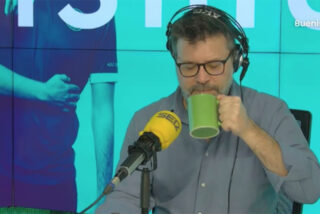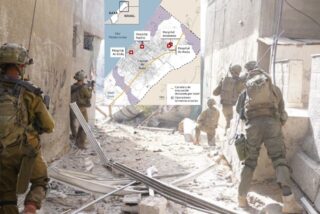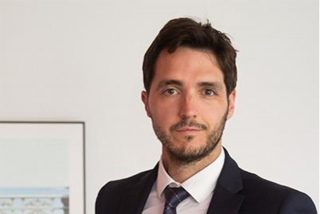 (Felipe Valdés, Periodista Digital).- Ali Shalal Qaissi era el preso 151716 en la prisión de Abu Ghraib en 2003 y 2004. Su imagen dio la vuelta al mundo, encapuchado, torturado, sobre una caja de cartón, unido a los alambres eléctricos con sus brazos estirados de par en par en una actitud misteriosa y profética. Se convirtió en el símbolo indeleble de la tortura en Abu Ghraib, al oeste de Bagdad. Hoy le conocemos.
(Felipe Valdés, Periodista Digital).- Ali Shalal Qaissi era el preso 151716 en la prisión de Abu Ghraib en 2003 y 2004. Su imagen dio la vuelta al mundo, encapuchado, torturado, sobre una caja de cartón, unido a los alambres eléctricos con sus brazos estirados de par en par en una actitud misteriosa y profética. Se convirtió en el símbolo indeleble de la tortura en Abu Ghraib, al oeste de Bagdad. Hoy le conocemos.
Este sábado el New York Times da a conocer su rostro.
 A sus 43 años, sabe lo que es el dolor físico, la humillación la tortura. “nunca deseé ser famoso, especialmente de esta manera”.Él ahora es un abogado que entiende claramente la energía de la imagen: aparece en su tarjeta de visita.
A sus 43 años, sabe lo que es el dolor físico, la humillación la tortura. “nunca deseé ser famoso, especialmente de esta manera”.Él ahora es un abogado que entiende claramente la energía de la imagen: aparece en su tarjeta de visita.
Bajo el poder de Saddam Hussein, Qaissi era un mukhtar, un papel dado típicamente a los miembros del partido predominante de Baath y atado de cerca a sus servicios de seguridad nebulosos.
Un artículo del rotativo estadounidense firmado por HASSAN M. FATTAH que vale la pena leer:
Symbol of Abu Ghraib Seeks to Spare Others His Nightmare
Mr. Qaissi, 43, was prisoner 151716 of Cellblock 1A. The picture of him standing hooded atop a cardboard box, attached to electrical wires with his arms stretched wide in an eerily prophetic pose, became the indelible symbol of the torture at Abu Ghraib, west of Baghdad. [The American military said Thursday that it would abandon the prison and turn it over to the Iraqi government.]
«I never wanted to be famous, especially not in this way,» he said, as he sat in a squalid office rented by his friends here in Amman. That said, he is now a prisoner advocate who clearly understands the power of the image: it appears on his business card.
At first glance, there is little to connect Mr. Qaissi with the infamous picture of a hooded man except his left hand, which he says was disfigured when an antique rifle exploded in his hands at a wedding several years ago. A disfigured hand also seems visible in the infamous picture, and features prominently in Mr. Qaissi’s outlook on life. In Abu Ghraib, the hand, with two swollen fingers, one of them partly blown off, and a deep gash in the palm, earned him the nickname Clawman, he said.
A spokesman for the American military in Iraq declined to comment, saying it would violate the Geneva Conventions to disclose the identity of prisoners in any of the Abu Ghraib photographs, just as it would to discuss the reasons behind Mr. Qaissi’s detention.
But prison records from the Coalition Provisional Authority, which governed Iraq after the invasion, made available to reporters by Amnesty International, show that Mr. Qaissi was in American custody at the time. Beyond that, researchers with both Human Rights Watch and Amnesty International say they have interviewed Mr. Qaissi and, along with lawyers suing military contractors in a class-action suit over the abuse, believe that he is the man in the photograph.
Under the government of Saddam Hussein, Mr. Qaissi was a mukhtar, in effect a neighborhood mayor, a role typically given to members of the ruling Baath Party and closely tied to its nebulous security services. After the fall of the government, he managed a parking lot belonging to a mosque in Baghdad.
He was arrested in October 2003, he said, because he loudly complained to the military, human rights organizations and the news media about soldiers’ dumping garbage on a local soccer field. But some of his comments suggest that he is at least sympathetic toward insurgents who fight American soldiers.
«Resistance is an international right,» he said.
Weeks after complaining about the garbage, he said, he was surrounded by Humvees, hooded, tied up and carted to a nearby base before being transferred to Abu Ghraib. Then the questioning began.
«They blamed me for attacking U.S. forces,» he said, «but I said I was handicapped; how could I fire a rifle?» he said, pointing to his hand. «Then he asked me, ‘Where is Osama bin Laden?’ And I answered, ‘Afghanistan.’ »
How did he know? «Because I heard it on TV,» he replied.
He said it soon became evident that the goal was to coax him to divulge names of people who might be connected to attacks on American forces. His hand, then bandaged, was often the focus of threats and inducements, he said, with interrogators offering to fix it or to squash it at different times. After successive interrogations, he said he was finally given a firm warning: «If you don’t speak, next time, we’ll send you to a place where even dogs don’t live.»
Finally, he said, he was taken to a truck, placed face down, restrained and taken to a special section of the prison where he heard shouts and screams. He was forced to strip off all his clothes, then tied with his hands up high. A guard began writing on his chest and forehead, what someone later read to him as, «Colin Powell.»
In all, there were about 100 cells in the cellblock, he said, with prisoners of all ages, from teenagers to old men. Interrogators were often dressed in civilian clothing, their identities strictly shielded.
The prisoners were sleep deprived, he said, and the punishments they faced ranged from bizarre to lewd: an elderly man was forced to wear a bra and pose; a youth was told to hit the other adults; and groups of men were organized in piles. There was the dreaded «music party,» he said, in which prisoners were placed before loudspeakers. Mr. Qaissi also said he had been urinated on by a guard. Then there were the pictures.
«Every soldier seemed to have a camera,» he said. «They used to bring us pictures and threaten to deliver them to our families»
Today, those photographs, turned into montages and slideshows on Mr. Qaissi’s computer, are stark reminders of his experiences in the cellblock. As he scanned through the pictures, each one still instilling shock as it popped on the screen, he would occasionally stop, his voice breaking as he recounted the story behind each photograph.
In one, a young man shudders in fear as a dog menaces him.
«That’s Talib,» he said. «He was a young Yemeni, a student of the Beaux-Arts School in Baghdad, and was really shaken.»
In another, Pfc. Lynndie R. England, who was convicted last September of conspiracy and maltreatment of Iraqi prisoners, poses in front of a line of naked men, a cigarette in her mouth. «That’s Jalil, Khalil and Abu Khattab,» he said. «They’re all brothers, and they’re from my neighborhood.»
Then there is the picture of Mr. Qaissi himself, standing atop a cardboard box, taken 15 days into his detention. He said he had only recently been given a blanket after remaining naked for days, and had fashioned the blanket into a kind of poncho.
The guards took him to a heavy box filled with military meal packs, he said, and hooded him. He was told to stand atop the box as electric wires were attached to either hand. Then, he claims, they shocked him five times, enough for him to bite his tongue.
Specialist Sabrina Harman was convicted last May for her role in abusing prisoners at Abu Ghraib, but she was accused of threatening to electrocute a hooded inmate on a box if he stepped off it, not of shocking him while he was atop it.
After almost six months in Abu Ghraib, Mr. Qaissi said, he was loaded onto a truck, this time without any shackles, but still hooded. As the truck sped out of the prison, another man removed the hood and announced that they had been freed.
With a thick shock of gray hair and melancholy eyes, Mr. Qaissi is today a self-styled activist for prisoners’ rights in Iraq. Shortly after being released from Abu Ghraib in 2004, he started the Association of Victims of American Occupation Prisons with several other men immortalized in the Abu Ghraib pictures.
Financed partly by Arab nongovernmental organizations and private donations, the group’s aim is to publicize the cases of prisoners still in custody, and to support prisoners and their families with donations of clothing and food.
Mr. Qaissi has traveled the Arab world with his computer slideshows and presentations, delivering a message that prisoner abuse by Americans and their Iraqi allies continues. He says that as the public face of his movement, he risks retribution from Shiite militias that have entered the Iraqi police forces and have been implicated in prisoner abuse. But that has not stopped him.
Last week, he said, he lectured at the American University in Beirut, on Monday he drove to Damascus to talk to students and officials, and in a few weeks he heads to Libya for more of the same.
Despite the cruelty he witnessed, Mr. Qaissi said he harbored no animosity toward America or Americans. «I forgive the people who did these things to us,» he said. «But I want their help in preventing these sorts of atrocities from continuing.»

—
20.02.06 19:04
NYT PIDE EL CIERRE DE GUANTÁNAMO Y ABU GHRAIB
 José Rosado (Periodista Digital).- The New York Times no quiere cárceles como Guantánamo o Abu Ghraib por lo que ha respaldado la petición de la Comisión de Derechos Humanos de Naciones Unidas para que se cierren ambas prisiones. En un editorial titulado “La vergüenza de las prisiones”, el diario ha recordado que EEUU todavía tiene responsabilidad por lo que suceda en esas prisiones.
José Rosado (Periodista Digital).- The New York Times no quiere cárceles como Guantánamo o Abu Ghraib por lo que ha respaldado la petición de la Comisión de Derechos Humanos de Naciones Unidas para que se cierren ambas prisiones. En un editorial titulado “La vergüenza de las prisiones”, el diario ha recordado que EEUU todavía tiene responsabilidad por lo que suceda en esas prisiones.
Según el editorial del diario, Estados Unidos “necesita una política de prisiones que se apegue a la ley y a los principios democráticos”. Este editorial ha sido publicado después del informe de Naciones Unidas, en el que denuncia los abusos de Guantánamo, y el reportaje de una televisión australiana que ponía en evidencia a EEUU por las torturas infligidas a los presos iraquíes.
Este diario considera que la respuesta del presidente Bush frente al informe de la ONU demostró su “usual respuesta débil” desde que decidiese que “hay un estado permanente de guerra que lo coloca por encima de otra ley”.
Además, pone de manifiesto que cuando los legisladores intentaron regular la situación de los presos en Guantánamo, a los que Bush ha negado cualquier derecho, se descubrieron más violaciones de los derechos humanos por lo que “la única solución es clausurarla y enjuiciar a los presos justamente”.









































